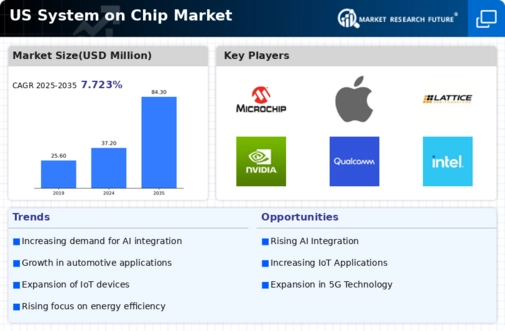Increased Investment in R&D
Investment in research and development (R&D) within the semiconductor industry is crucial for driving innovation in the system on-chip market. As companies strive to develop next-generation technologies, the US semiconductor R&D spending is projected to reach $20 billion annually by 2026. This influx of funding is likely to facilitate advancements in chip design, manufacturing processes, and integration techniques, which are essential for meeting the evolving demands of various applications. Enhanced R&D efforts may lead to the development of more powerful and efficient system on-chip solutions, thereby fostering competitiveness in the market. As a result, the system on-chip market is expected to benefit from these investments, potentially leading to new product offerings and improved performance.
Expansion of 5G Infrastructure
The rollout of 5G technology is poised to revolutionize various industries, necessitating advanced processing capabilities that system on-chip solutions can provide. In the US, the 5G infrastructure investment is projected to exceed $275 billion by 2025, indicating a substantial opportunity for the system on-chip market. These chips are critical for enabling high-speed data transmission and low-latency communication, which are essential for applications such as augmented reality, smart cities, and enhanced mobile broadband. As telecommunications companies and device manufacturers seek to capitalize on the benefits of 5G, the demand for specialized system on-chip solutions is likely to surge, further solidifying their role in the evolving technological landscape.
Rising Focus on Edge Computing
The shift towards edge computing is reshaping data processing by emphasizing computations closer to the data source.. This trend is significantly impacting the system on-chip market, as these chips are ideally suited for edge devices that require low power consumption and high efficiency. In the US, the edge computing market is anticipated to reach $15 billion by 2025, driven by the need for real-time data processing in various applications, including healthcare, manufacturing, and smart cities. System on-chip solutions can integrate multiple functionalities into a compact form factor, making them attractive for edge computing scenarios., suggesting a promising growth trajectory for the market.
Surge in Demand for IoT Devices
The increasing proliferation of Internet of Things (IoT) devices is driving the system on-chip market. As more devices become interconnected, the need for efficient and compact processing solutions intensifies. In the US, the IoT market is projected to reach approximately $1 trillion by 2026, which suggests a substantial demand for system on-chip solutions that can handle diverse applications, from smart home devices to industrial automation. This trend indicates that manufacturers are likely to invest heavily in developing specialized chips that cater to the unique requirements of IoT applications, thereby propelling growth in the system on-chip market. Furthermore, the integration of advanced features such as machine learning capabilities within these chips may enhance their appeal, potentially leading to increased adoption across various sectors.
Growth in Automotive Electronics
The automotive sector is undergoing a significant transformation towards electric and autonomous vehicles.. This evolution is creating a robust demand for advanced electronic systems, particularly in the system on-chip market. In the US, the automotive electronics market is expected to surpass $300 billion by 2025, driven by the need for sophisticated control systems, infotainment, and safety features. System on-chip solutions are essential for integrating multiple functionalities into a single chip, which can reduce costs and improve performance. As automakers increasingly adopt these technologies, the system on-chip market is likely to experience accelerated growth, reflecting the industry's commitment to innovation and efficiency.





















Leave a Comment